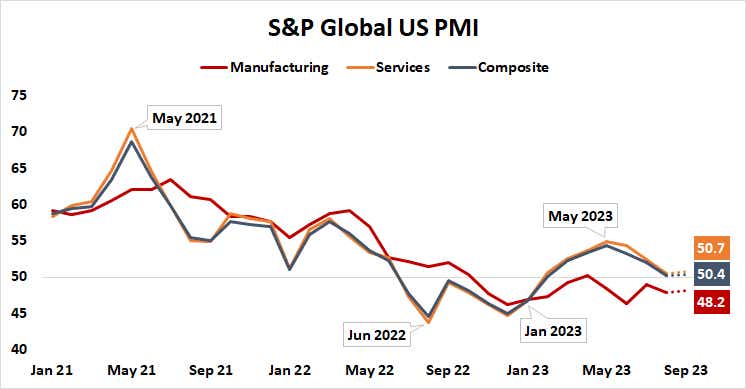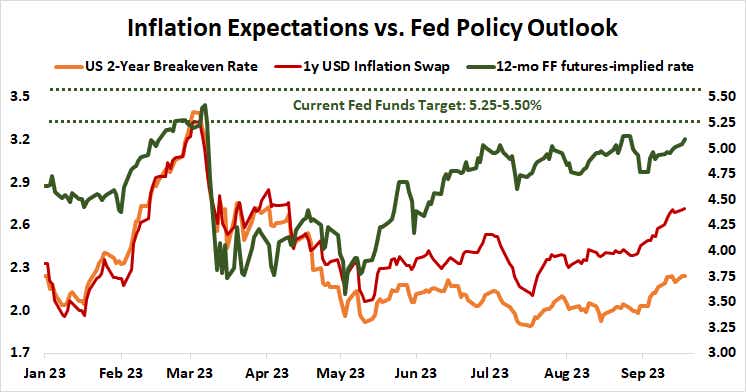Stocks Are at Risk Even if the FOMC Meeting Changes Nothing

Stocks Are at Risk Even if the FOMC Meeting Changes Nothing
By:Ilya Spivak
Stock markets may fall after the Fed policy announcement even if the priced-in rates outlook is little-changed
- The Fed is widely expected to keep rates unchanged in September, eyeing cuts in 2024.
- Narrowly tuned market pricing sets the stage for volatility as traders reposition.
- Markets may default to a “risk-off” response even on status-quo Fed guidance.
The mystery seems all but gone from September’s Federal Reserve monetary policy decision. Nevertheless, it's likely that a potent market-moving outing looms ahead.
Officials are overwhelmingly expected to keep the target range for the benchmark Fed Funds unchanged at 5.25% to 5.50%. The priced-in probability of a 25-basis-point (bps) increase is a paltry 0.8%. The cumulative likelihood of such an increase before year-end peaks at 45% in December, before the focus quickly shifts to rate cuts in the second half of 2024.
The first 25 bps reduction is expected by July. Another one is fully priced in by November, with an 84% probability of a third by the end of 2024. That would put Fed Funds in a target band of 4.50% to 4.75% by the end of next year. That range lines up neatly with the Fed’s June forecast putting the median rate at 4.6% next year.
Fed faces tough balancing act as inflation bets rise, growth cools
The markets appear precisely tuned for a status-quo result, implying that any changes to the forecast have scope to push asset values around as traders reposition.
Investors’ priced-in inflation expectations have been creeping higher since the beginning of the month, inviting Chair Jerome Powell and his colleagues on the FOMC rate-setting committee to retort. Pushing the 2024 rate forecast to 4.8% or higher might follow. Revising expected inflation higher in tandem would cement the point.
Pulling in the opposite direction, Purchasing Managers Index (PMI) data suggests economic growth has cooled to near standstill. September’s update due this week is projected to put the composite PMI gauge at 50.4, a hair above August’s six-month low of 50.2 and worryingly close to the 50 boom-bust threshold separating expansion and contraction.

Stock markets at risk after FOMC announcement
The balance of risks for any adjustments seems adversely tilted for stocks as well as cyclically minded currencies and commodities like the Australian dollar and copper. Signaling a “higher for longer” rates path might spook investors worried about global recession. A dovish dispensation might be seen as endorsing those very fears.
Beyond economic projections, the statement accompanying the policy decision as well as the press conference with Powell following the announcement will give traders plenty of fodder to consider. That leaves ample room for speculation at a moment when the window for “risk-on” stability seems especially narrow.
Finally, even a perfectly executed balancing act may be met with a strong response. Markets are acutely aware that the Fed’s inflation fight threatens to kick out the last bit of support for global growth. China has struggled to reboot since emerging from COVID-19 lockdowns in December and the Eurozone may be in recession already.
If the U.S. central bank manages to keep speculation on its own actions relatively steady, their implications for the worldwide economy may still seem sobering. Without an obvious reprieve—an unlikely result, which could yet backfire if it appears too defensive (as noted above)—a “risk-off” result may be default.

Ilya Spivak, tastylive head of global macro, has 15 years of experience in trading strategy, and he specializes in identifying thematic moves in currencies, commodities, interest rates and equities. He hosts Macro Money and co-hosts Overtime, Monday-Thursday. @Ilyaspivak
For live daily programming, market news and commentary, visit tastylive or the YouTube channels tastylive (for options traders), and tastyliveTrending for stocks, futures, forex & macro.
Trade with a better broker, open a tastytrade account today. tastylive, Inc. and tastytrade, Inc. are separate but affiliated companies.
Options involve risk and are not suitable for all investors. Please read Characteristics and Risks of Standardized Options before deciding to invest in options.
tastylive content is created, produced, and provided solely by tastylive, Inc. (“tastylive”) and is for informational and educational purposes only. It is not, nor is it intended to be, trading or investment advice or a recommendation that any security, futures contract, digital asset, other product, transaction, or investment strategy is suitable for any person. Trading securities, futures products, and digital assets involve risk and may result in a loss greater than the original amount invested. tastylive, through its content, financial programming or otherwise, does not provide investment or financial advice or make investment recommendations. Investment information provided may not be appropriate for all investors and is provided without respect to individual investor financial sophistication, financial situation, investing time horizon or risk tolerance. tastylive is not in the business of transacting securities trades, nor does it direct client commodity accounts or give commodity trading advice tailored to any particular client’s situation or investment objectives. Supporting documentation for any claims (including claims made on behalf of options programs), comparisons, statistics, or other technical data, if applicable, will be supplied upon request. tastylive is not a licensed financial adviser, registered investment adviser, or a registered broker-dealer. Options, futures, and futures options are not suitable for all investors. Prior to trading securities, options, futures, or futures options, please read the applicable risk disclosures, including, but not limited to, the Characteristics and Risks of Standardized Options Disclosure and the Futures and Exchange-Traded Options Risk Disclosure found on tastytrade.com/disclosures.
tastytrade, Inc. ("tastytrade”) is a registered broker-dealer and member of FINRA, NFA, and SIPC. tastytrade was previously known as tastyworks, Inc. (“tastyworks”). tastytrade offers self-directed brokerage accounts to its customers. tastytrade does not give financial or trading advice, nor does it make investment recommendations. You alone are responsible for making your investment and trading decisions and for evaluating the merits and risks associated with the use of tastytrade’s systems, services or products. tastytrade is a wholly-owned subsidiary of tastylive, Inc.
tastytrade has entered into a Marketing Agreement with tastylive (“Marketing Agent”) whereby tastytrade pays compensation to Marketing Agent to recommend tastytrade’s brokerage services. The existence of this Marketing Agreement should not be deemed as an endorsement or recommendation of Marketing Agent by tastytrade. tastytrade and Marketing Agent are separate entities with their own products and services. tastylive is the parent company of tastytrade.
tastyfx, LLC (“tastyfx”) is a Commodity Futures Trading Commission (“CFTC”) registered Retail Foreign Exchange Dealer (RFED) and Introducing Broker (IB) and Forex Dealer Member (FDM) of the National Futures Association (“NFA”) (NFA ID 0509630). Leveraged trading in foreign currency or off-exchange products on margin carries significant risk and may not be suitable for all investors. We advise you to carefully consider whether trading is appropriate for you based on your personal circumstances as you may lose more than you invest.
tastycrypto is provided solely by tasty Software Solutions, LLC. tasty Software Solutions, LLC is a separate but affiliate company of tastylive, Inc. Neither tastylive nor any of its affiliates are responsible for the products or services provided by tasty Software Solutions, LLC. Cryptocurrency trading is not suitable for all investors due to the number of risks involved. The value of any cryptocurrency, including digital assets pegged to fiat currency, commodities, or any other asset, may go to zero.
© copyright 2013 - 2025 tastylive, Inc. All Rights Reserved. Applicable portions of the Terms of Use on tastylive.com apply. Reproduction, adaptation, distribution, public display, exhibition for profit, or storage in any electronic storage media in whole or in part is prohibited under penalty of law, provided that you may download tastylive’s podcasts as necessary to view for personal use. tastylive was previously known as tastytrade, Inc. tastylive is a trademark/servicemark owned by tastylive, Inc.